How do presidential candidates, their campaigns and their supporters attempt to win the vote of the American electorate?
For a hundred years after the Civil War, Iowa was a reliably Republican state. Only during the crisis of the Great Depression in the 1930s did Iowa show up in the Democratic column on election night. However, beginning the 1950s, the Democratic Party took on new life in the face of rural/urban divisions, the growing strength of labor unions, and attention to national issues like civil rights and the Vietnam War. Cities pushed for more equitable representation in the legislature against rural resistance.
Despite its smaller size and population, Iowa became very important in the election of a U.S. President. Each state has its own process for selecting delegates to national political conventions where the parties nominate their candidates. Iowa uses a caucus system. Members of each party meet together in local meetings called caucuses to select delegates to a county convention that chooses delegates to the district and state conventions. The state conventions are held in June and choose delegates to the national convention. Because the process takes many months, the local caucus has to meet in January or early February to get all the steps done. Because of that timing, the Iowa caucus becomes the first official step anywhere in the nation in selecting a president, and news reporters flock to the state to find out which candidates are ahead.
Candidates Find Democratic Foothold in Iowa
In 1972, Senator George McGovern gained national attention when he came out on top of the Iowa caucuses. In 1976, Jimmy Carter made a major effort to score well in Iowa. He did and went on to become the Democratic Party’s nominee, and eventually, the president of the United States. After that, the Iowa caucus attracted national attention as candidates from both parties flocked to the state to make their case to Iowa voters in local cafes, church basements, and similar venues. The winner of the Iowa caucus doesn’t always become the party’s candidate, but a poor showing in Iowa often leads candidates to withdraw.
From its early years when Republicans almost always won most elections, Iowa now has two competitive parties. Nevertheless, Iowa voters tend to keep incumbents in office. Harold Hughes, a Democrat, and Robert Ray, a Republican, both won re-election to the governorship several times, and Terry Branstad became the longest serving governor in U.S. history. Charles Grassley and Tom Harkin represented different parties but both hung on to their U.S. Senate seats through multiple elections. The majority in the legislature, however, has shifted numerous times, sometimes even split between the state senate and the state house.
Supporting Questions
How do presidential candidates, campaigns and their supporters portray their political opponents?
- "King Andrew the First," 1832 (Image)
- "An Available Candidate: The One Qualification for a Whig President" Political Cartoon, 1848 (Image)
- "Save America" Speech, 1920 (Audio)
- "Peace, Little Girl (a.k.a. Daisy)," 1964 (Video)
What kind of positive images do campaigns and their supporters create for their presidential candidates?
- "Farmer Garfield: Cutting a Swath to the White House" Campaign Poster, 1880 (Image)
- "The Song of Armageddon," 1912 (Document)
- "Stonewall Wilson" Song, 1916 (Document)
- "Safeguard America!" Speech, 1920 (Audio)
- "Hoover the Humanitarian!," 1928 (Document)
How do presidential candidates and their campaigns attempt to establish a personal connection with the electorate?
- "For President of the People, Zachary Taylor," 1848 (Image)
- "Letter from Thomas T. Swann to Abraham Lincoln," 1860 (Document)
- Ulysses S. Grant Campaign Poster, 1872 (Image)
- "Eleven Reasons Why Iowa Should Re-elect Senator Cummins" Leaflet, 1920 (Document)
- Presidential Candidate Henry A. Wallace Campaigns at William Penn College, 1948 (Image)
| Caucuses and Elections Source Set Teaching Guide |
| Printable Image and Document Guide |
“King Andrew the First,” 1833
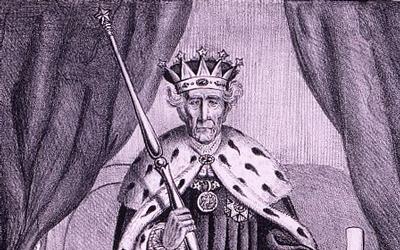
Description
The caricature is of Andrew Jackson as a despotic monarch, probably issued during the fall of 1833 in response to the president's September order to remove federal deposits from the Bank of the United States. The print is dated a year earlier by Weitenkampf and related to…
“An Available Candidate: The One Qualification for a Whig President” Political Cartoon, 1848
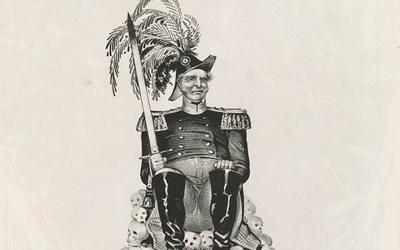
Description
This political cartoon shows a man in a military uniform, with epaulets and a plumed hat, holding a sword and seated on a pile of skulls. The cartoon serves as a scathing attack on Whig principles, as embodied in their selection of a presidential candidate for 1848.…
"Save America" Speech, 1920
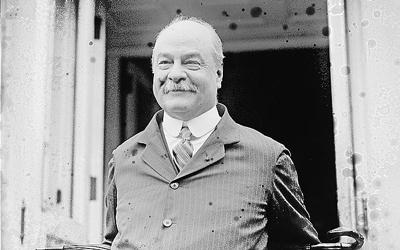
Description
This speech was made by Nicholas Murray Butler, the president of Columbia University. The speech, made in 1920, was in support of the Republican Party, which Butler said will lead and guide the United States to avoid division. He said, "There are elements in our…
“Peace, Little Girl (a.k.a. Daisy),” September 7, 1964

Description
Arguably the most famous television campaign advertisement in history, “Peace, Little Girl (a.k.a. Daisy)” depicts a young girl peacefully picking flower petals only to be interrupted by a countdown and nuclear explosion, followed by a request for voters to re-elect…
“Farmer Garfield: Cutting a Swath to the White House” Campaign Poster, 1880
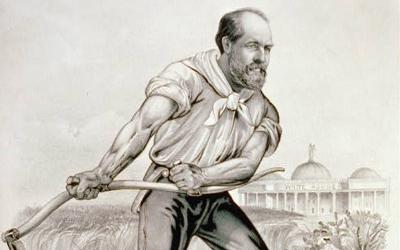
Description
James A. Garfield, Republican candidate for president in 1880, is depicted as a farmer in his wheat field using a scythe to clear his wheat field of both weeds and dangerous snakes. His "scythe" holds the words honesty, ability and patriotism, as he swipes at the "…
"The Song of Armageddon," 1912
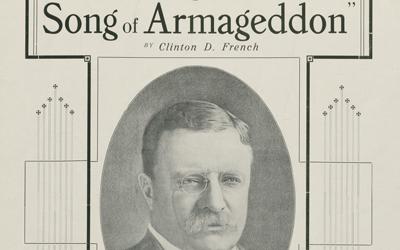
Description
"The Song of Armageddon" emphasizes the Progressive Party’s call for honesty in government and the major political parties in 1912. The song was composed by Clinton D. French.
“Stonewall Wilson” Song, 1916
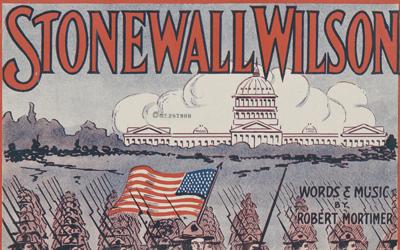
Download Resource Download Resource
Description
“Stonewall Wilson” is a song supporting the 1916 re-election campaign of President Woodrow Wilson. It depicts Wilson as a strong, dependable leader both militarily and economically. Wilson won the election and defeated Supreme Court Justice Charles E. Hughes - the…
"Safeguard America!" Speech, 1920
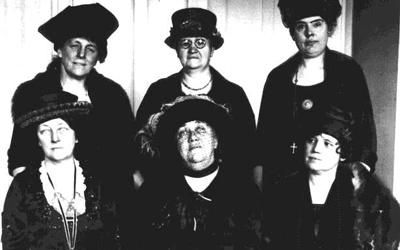
Description
The speech was made by Corinne Roosevelt Robinson, the sister of President Theodore Roosevelt. She was supporting the Republican ticket of Senator William Harding and Governor Calvin Coolidge in the 1920 general election as "100 percent American, true patriotism, who have…
“Hoover the Humanitarian!,” 1928
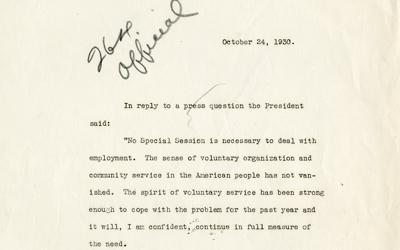
Description
The campaign literature contains information on Herbert Hoover's humanitarian efforts during World War I that was used during his presidential campaign in 1928. This pro-Hoover pamphlet focuses on his achievements in the mining industry and during World War I as…
“For President of the People, Zachary Taylor,” 1846
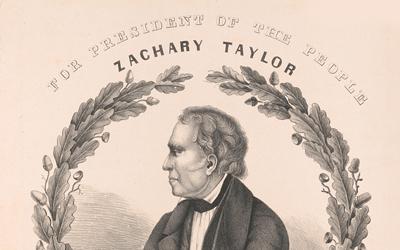
Description
This print shows a campaign banner for Whig presidential candidate Zachary Taylor. Although Taylor was not formally nominated by the Whigs until June 1848, he had already begun to attract a following in 1846. Here is a half-length portrait of Taylor, in civilian dress, head…
Letter from Thomas T. Swann to Abraham Lincoln, June 15, 1860
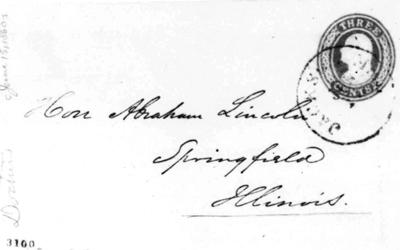
Description
In his letter to the newly-nominated Republican candidate for president, Thomas T. Swann requests an explanation of Abraham Lincoln’s positions on five important issues. Swann served as a politician in Maryland. He was most known for pushing back against abolitionists…
Ulysses S. Grant Campaign Poster, 1872
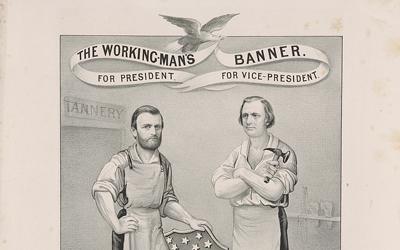
Description
This campaign poster depicts the 1872 Republican presidential nominee Ulysses S. Grant as a tanner working alongside his running mate Henry Wilson, who is drawn as a shoemaker. The print shows a Republican campaign banner designed to appeal to the labor vote by invoking the…
“Eleven Reasons Why Iowa Should Re-Elect Senator Cummins” Leaflet, 1920
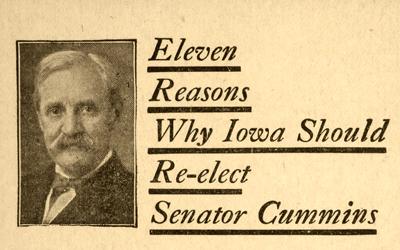
Description
This 1920 campaign leaflet listed 11 reasons as to why Iowa should re-elect Senator Albert B. Cummins. He was the 18th governor of Iowa and served as the U.S. Senator for Iowa for 18 years. Cummins was a member of the Republican Party.
Presidential Candidate Henry A. Wallace Campaigns at William Penn College, 1948
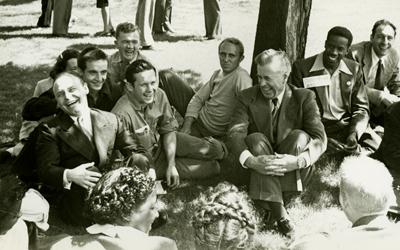
Description
The 1948 Progressive Party presidential candidate, Henry A. Wallace, right of center and in front of tree, is seen visiting with William Penn College president, Cecil Hinshaw, far left, and students on the campus grounds in Oskaloosa, Iowa. Wallace, who was a native to Iowa…
Additional Resources:
- The Living Room Candidate
"The Living Room Candidate" website contains more than 300 commercials from every presidential election since 1952. - Pictorial Americana: Selected Images from the Collections of the Library of Congress - Presidential Campaigns
This website from the Library of Congress contains primary sources related to each presidential campaign between the years 1836 and 1908. - Presidential Campaign Posters from the Library of Congress
This website is a companion to the Library of Congress’ book, Presidential Campaign Posters From the Library of Congress: Two Hundred Years of Election Art. - "Some Account of Some of the Bloody Deeds of General Jackson"
One of the most well-known “coffin hand bills” distributed during the election of 1828.
Iowa Core Social Studies Standards (9-12)
Listed below are the Iowa Core Social Studies content anchor standards that are best reflected in this source set. The content standards applied to this set are high school-age level and encompass the key disciplines that make up social studies for 9-12th grade students.
| No. | Standard Descriptions |
| SS-Psy.9-12.14. | Examine how an individual's involvement in collective group can influence their individual thoughts and behaviors. |
| SS-Psy.9-12.15. | Analyze the influence different individual members of a group can have on the collective thought and behavior of the group as a whole. |
| SS-Soc.9-12.13. | Explain the formation of groups and the creation and development of societal norms and values. |
| SS-Soc.9-12.14. | Identify characteristics of groups, and the influences that groups and individuals have on each other. |
| SS-Soc.9-12.17. | Analyze the development of sociological perspectives over the course of time, and how those perspectives are used today. |
| SS-Gov.9-12.18. | Critique the influence of intermediary institutions on government and policy such as, interest groups, political parties, the mass media, campaigns, caucuses, elections, PACs, and local, state, tribal, and international organizations. (21st century skills) |
| SS-Gov.9-12.20. | Explain the significance of civic values to a well-functioning democracy including concepts such as conviction vs. compromise, majority rule vs. minority rights, state interests vs. individual interests, rights vs. responsibilities, and other related topics. (21st century skills) |
| SS-Gov.9-12.26. | Analyze the historical, contemporary, and emerging patterns of political action and activism including voter demographics, party trends over time, polling data, campaign strategies and trends, and alternative means of participating. (21st century skills) |
| SS-US.9-12.13 | Analyze how diverse ideologies impacted political and social institutions during eras such as Reconstruction, the Progressive Era, and the Civil Rights movement. |
| SS-US.9-12.15. | Assess the impact of individuals and reform movements on changes to civil rights and liberties. (21st century skills) |
| SS-US.9-12.22. | Evaluate the impact of inventions and technological innovations on the American society and culture. |
| SS-US.9-12.23. | Analyze the relationship between historical sources and the secondary interpretations made from them. |
| SS-US.9-12.24. | Critique primary and secondary sources of information with attention to the source of the document, its context, accuracy, and usefulness such as the Reconstruction amendments, Emancipation Proclamation, Treaty of Fort Laramie, Chinese Exclusion Act, Roosevelt’s Corollary to the Monroe Doctrine, Wilson’s Fourteen Points, New Deal Program Acts, Roosevelt’s Declaration of War, Executive Order 9066, Truman Doctrine, Eisenhower’s Farewell Speech, Gulf of Tonkin Resolution, Test Ban Treaty of 1963, Brown vs. Board of Education decision, Letter from a Birmingham Jail, and the Voting Act of 1965. |
| SS-US.9-12.26. | Determine multiple and complex causes and effects of historical events in American history including, but not limited to, the Civil War, World War I and II, the Korean War and the Vietnam War. |
| SS-US.9-12.27. | Evaluate Iowans or groups of Iowans who have influenced U.S. History. |
| SS-WH.9-12.17. | Evaluate the consequences of human made and natural catastrophes on global trade, politics, and human migration. |
| SS-WH.9-12.20. | Evaluate methods used to change or expand systems of power and/or authority. |
| SS-WH.9-12.21. | Investigate cultural advancements within societies with attention to belief systems, ideologies, the arts, science and technology. |
| SS-WH.9-12.23. | Critique primary and secondary sources of information with attention to the source of the document, its context, accuracy, and usefulness of sources throughout world history. |